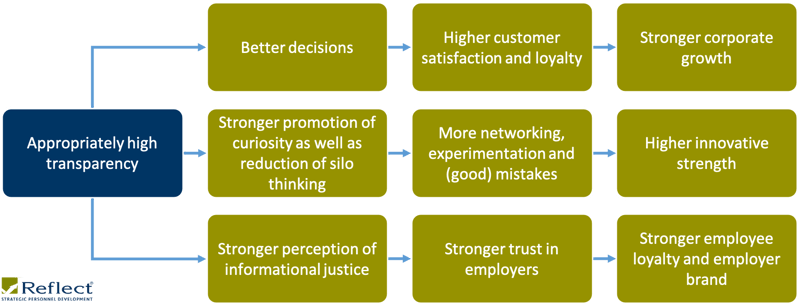Secrecy vs. transparency
How much transparency is appropriate?
Knowledge is power - knowledge shared is power multiplied
"Knowledge is power" was already stated by Francis Bacon in the 16th century. And this dictum has always been true in a business context. Both in the 20th century, when companies were able to prevail over their competitors through knowledge of faster production methods (Ford) or secret recipes (Coca-Cola); and in the 21st century, in a globalized, digitalized and volatile world.

Knowledge was and is an intangible resource which, if used correctly, can form a basis for a competitive advantage - we have known this at least since "resource-based-view" found its way into management theory in the 1990s.
How knowledge can be used as a resource and developed into a core competence in order to gain a competitive advantage from it - is not part of this note - here we are dedicated to the topic of "transparency". However, we would like to recommend at this point that you take a closer look at the concept of VRIO analysis (Value, Rareness, Imitability, Organization), which can be used to determine which knowledge can be developed into a core competence in your company.
But back to the actual topic of transparency. What has changed radically in recent years is the way knowledge is handled. Whereas in the past "knowledge is power - so I have to keep it to myself to stay powerful", today "knowledge is power - and sharing knowledge makes you more powerful" increasingly applies.
The way companies deal with knowledge has changed. Many companies have realized that a VUCA world makes different demands on them and their employees than a complicated but controllable market environment, as we often found it until about 25 years ago.
So - share (your knowledge) and rule?
It's not quite that simple. In the following, we will analyze how and under which circumstances transparency in companies makes sense and creates value, and in which context secrecy and confidentiality have their raison d'être.
Why is it important to embed transparency in the corporate culture?
The organizational theories of the last decade, whether evolutionary, healthy, agile, responsive, peach, or "teal" organizations, all point out that one answer to volatile markets is: customer-centricity - and thus empowering employees who are customer- and market-focused.
Simply broken down: If you want to adapt quickly to changing customer and market requirements, you have to ensure that the employees "on the front lines" can also make the right decisions and act quickly. They are supported in this by being empowered. For example, through knowledge.
If a customer comes into my store and I, as a customer advisor, can immediately check in a CRM program whether and when and for what purpose this customer has already been to my store or another store in my company - I can advise him or her in a targeted manner.
Let's take this example a step further: When the customer leaves the store again later, I as a consultant again share information about the customer visit via CRM with my relevant internal stakeholders.
In this case, with other customer advisors, with central sales and the strategy department - who, based on this and hundreds to thousands of other customer visit information, develop a procedure for advising customers even better in the future - or to put it less romantically: How, as a company, they can bring more customers into our stores more often to sell them more or more expensive services or products.
Lesson learned: Sharing knowledge is not a one-way street. Transparency means not only sharing knowledge top-down, but also bottom-up. Knowledge must flow, it must be networked in the right places to add value to companies. And: the right technology helps to disseminate knowledge in a targeted manner.
But we are learning even more from the organizational theories of recent years. Among them, that companies need to focus more on offering purpose to their employees, treating them fairly, and encouraging them to ask questions and make good mistakes.
These factors suffer when companies are too committed to secrecy and confidentiality. As a business owner, if I want my colleagues to ask "why" questions and think entrepreneurially, I need to show that this is what they want and be able to offer answers.
If I want them to act in the interests of the company, I must also be able to let them discover and experience the "meaning of the company".
If I want them to act and decide as responsible adults in the company, I must also give them the opportunity to see, connect, and use information to work together to make the company a success.
If I want them to grow, I should see information and knowledge as fertilizer.
The following graphic illustrates how transparency can impact a company. Of course, the factors shown are only an excerpt and are in fact interrelated in a complex way.

Internal and external transparency: Tesla and allsafe Jungfalk lead the way
It makes sense to differentiate between internal and external transparency.
Internal transparency means: Within a company, there is a willingness to share knowledge and information.
External transparency means: A company deals openly with "own" knowledge and shares it proactively with partners, service providers, but also competitors or even the general public.
An example of high, external transparency is Elon Musk's announcement in 2014 that he would make all Tesla patents publicly available. Of course, this was not a pure act of charity. The calculation was: if other car manufacturers used these patents to produce e-cars themselves, Tesla would benefit from, among other things, a better charging infrastructure as well as a market that was more open to electric cars.
The example shows: High transparency through shared knowledge seems to make Tesla more powerful than keeping the knowledge to itself alone. The current share price seems to reflect that.
In contrast, the company allsafe Jungfalk is an example of high, internal transparency.
Detlef Lohmann, who calls himself "beta boss," introduced absolute transparency of figures years ago. This provides employees with a comprehensive basis of information so that they can act as entrepreneurs within the company. They are empowered to make better decisions for the company.
A win-win situation that also pays off economically for allsafe Jungfalk.
Is there "too much transparency"? And in what context does secrecy continue to make sense?
A very striking example of the usefulness of secrecy (internal and external) is restructuring. In restructuring processes, it makes sense to initially maintain confidentiality along a clear information strategy until important decisions have been made.
Once the scope, process and consequences of the restructuring or reorganization have been decided, targeted communications can be made in order to offer employees in particular as much security as possible.
Let's imagine that a restructuring process caused by a crisis would be handled in an absolutely transparent manner. All employees and stakeholders would receive weekly updates on the deliberations of the group entrusted with the restructuring:
Week 1: "Initial analyses show that we will probably have to lay off 100 employees in Plant A - but we are looking into this in more detail."
Week 2: "We have brought in consultants and, according to the latest findings, it looks as if only 50 employees will be affected after all".
Week 3: "Update: The first analyses were based on overly optimistic assumptions - and so were the consultants' conclusions. Unfortunately, we will have to lay off a total of 200 employees. And that in Plant B and C. Fortunately, Plant A is not affected.
What a mess! Despite the best of intentions, absolute transparency in this crisis situation would cause confusion, a lack of trust and untrustworthiness. The impact on the company's rating as well as the mood of the employees - catastrophic.
Of course, there are also examples of how, in such situations, too much secrecy can lead to employees finding out about the company crisis from the newspaper.
That's why successive transparency plays an important role, especially in crisis contexts. And this is one of the reasons why we are not promoting merciless transparency, but rather an appropriately high level of transparency. To achieve this, most companies, for the most part, need to become more transparent rather than less transparent.
One more note: The perception of "too much transparency" can also stem from the fact that too much knowledge is available and employees experience a flood of information. Knowledge needs to be retrievable, digestible, prioritized, and thus relevant.
In one of our last notes (Control vs. Empowerment), we showed that the information relevant to the respective employee must be meaningfully bundled in order to be able to accelerate and/or improve a decision or action.
Where do you start with transparency? How do you "start" an open corporate culture?
Transparency is a state, and openness is one of the underlying mindsets. To make a company more transparent, the fastest and most effective lever lies with management. Their actions and decisions must reflect openness and must strive for transparency.
For example, the management can radiate openness and achieve transparency, proximity and credibility by publishing sequences of minutes on the intranet, by holding Q&A sessions accessible to all employees via video conferencing or by posting pragmatic selfie videos on the internal YouTube channel after important meetings.
A small tip at this point: Achieving transparency is quicker and easier if the standard for meeting minutes is changed so that it is necessary to mark what must not be communicated under any circumstances instead of marking what should be published the other way around. In everyday life, this sharpens the sense of regularly questioning oneself as to where secrecy must be practiced - instead of questioning oneself as to where one could be more transparent.
And another tip: If it is not yet possible to communicate content, employees can still receive process information. A "We are working on topic X and will be able to report on it in more detail in 2 weeks" can provide security and peace of mind, as employees recognize that the leadership is working on relevant topics and is committed to making a decision and publishing it soon.
Transparency can be very effectively embedded in the corporate culture by making performance management, career systems and compensation management accessible and understandable.
Cultures evolve along corporate structures - changing them creates cultural change. In the case of performance management, this means making corporate, team and individual goals visible. This strengthens motivation and alignment.
For career systems, it means making job and role requirements accessible and providing clarity about development prospects. And for compensation management, it means presenting a comprehensible compensation concept transparently to all employees (see also our note on salary transparency).
If these topics are transparent, they are "off the table" - you save yourself countless discussions and ambiguities and lay the foundation for a trusting working relationship and thus for a transparent company.
Conclusion
In dynamic market environments, companies will have to become more transparent, both internally and externally, in order to keep pace with competitors, customers and the needs of their employees.
One hundred percent transparency, however, makes little sense, as it can lead to uncertainty and information overload. The goal must therefore be to achieve an appropriately high level of transparency - and this is often higher than the status quo.
Appropriately high transparency does not mean sharing every detail, but providing context for the company's actions and management decisions.
Anchoring transparency in a corporate culture is most easily accomplished by senior management and HR leaders. It is here that the seeds can be sown that provide trust, equity and openness, which are then watered and further developed by all members of the organization.
Literature:
https://www.brandeins.de/magazine/brand-eins-wirtschaftsmagazin/2012/das-gute-leben/der-beta-chef
https://www.humanresourcesmanager.de/news/transparenz-im-unternehmen-die-3-top-themen.html

